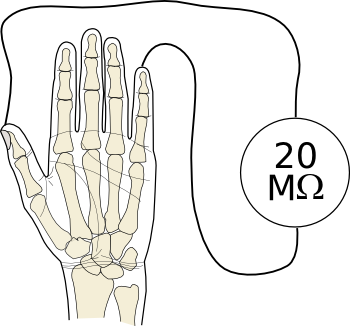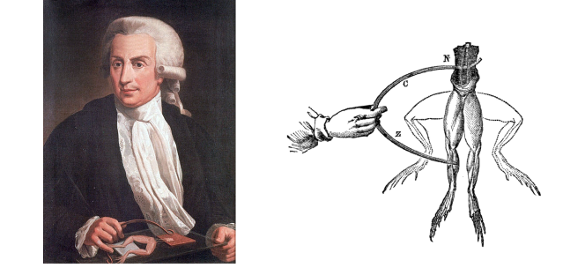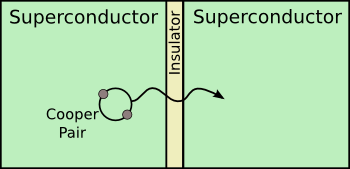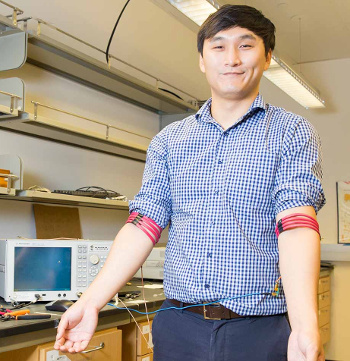The Body Magnetic
October 15, 2015
As anyone who's gotten an
electrical shock from a
switch plate knows, the
human body conducts
electricity. This also demonstrates that the human body can store
electrical charges generated by walking across
carpet fabric in low
humidity. If you have an
ohmmeter at home, you can measure your own
electrical resistance, which is the
reciprocal of
conductance.
For
safety reasons, however, it's required that you never do any such measurements across the
torso, as from one
hand to another. The
battery voltages of most of today's ohmmeters are small, but application of any
current through the torso can be dangerous. Also, do not puncture your
skin to do this measurement, since one known
fatality has occurred this way.[1]
I just measured my resistance from the
thumb to
little finger of my right hand. The value I got, about 20
megohm (20 MΩ), is higher than what would be expected. I needed to use a sensitive ohmmeter, since I obtained no reading on a less expensive, 2 megohm fullscale, meter. Typical values for dry skin are in the 100
kΩ range, with wet skin being in the 1 kΩ range. The
contact area was just the sides of the probe tips. Using larger area
electrodes, perhaps with
brine or a conductive paste, might have given a lower value.

My measurement of my own skin resistance.
Note that I did not let the current of the ohmmeter pass through my torso, just from the thumb to the little finger of my right hand.
(Wikimedia Commons image, modified using Inkscape.)
Electricity was an exciting thing in the early days after its discovery. There was the idea that electricity was the
vital force of
living creatures, as presented in modern adaptations of
Mary Shelley's Frankenstein (1818). Shelley's original book didn't mention electricity, but the concept was worked into a revised 1831 edition.
The
scientific basis for this comes from
Luigi Galvani's discovery that electrical excitation caused movement in the
legs of a
dissected frog (see figure). Such reanimation of a dead organism was, of course, sensational.

Italian physicist, Luigi Galvani (1737-1798), and a diagram of his frog experiment from an 1859 science textbook. (Images, left, right, via Wikimedia Commons.)
Since both electricity and
magnetism are easily observed
natural phenomena, it was inevitable that someone would postulate the existence of an "
animal magnetism." Animal magnetism, proposed by the
German physician,
Franz Mesmer, wasn't magnetism in the sense that
physicists understand the term. It was supposedly an
invisible natural force generated by animals. Animal magnetism had supposed
medicinal properties, and people were persuaded to believe in its existence from the late
18th century into the early
20th century, along with many other primitive medical
theories.
The human body does exhibit real magnetism, albeit at a very low level. Fortunately, modern science now has sensitive
SQUID magnetometers that allow detection of very small
magnetic fields. SQUIDS are based on the
interference of
quantum states in
Josephson junctions embedded in
superconducting materials. Magnetic regions of the
brain have been
magnetically imaged in a technique called
magnetoencephalography.

The simple idea that pairs of electrons could tunnel through a thin insulating barrier secured the 1973 Nobel Prize in Physics for Brian Josephson.
(Rendered using Inkscape.)
The
X-men villain,
Magneto,
uses the supposed magnetism of
blood hemoglobin as a
weapon by drawing it out of the body. Hemoglobin, however, is not
ferromagnetic, it's just weakly
paramagnetic, so it's barely attracted to even the strongest
magnets.
Transformers are devices that use the
Faraday law of induction to transmit electrical
energy through a magnetic medium by converting an
oscillating current to an oscillating magnetic field, conducting it through the magnetic medium, and then converting it back to an oscillating electrical current. A simple transformer, as shown in the figure, does this with two
coils and a
core of high magnetic
permeability. For greater
efficiency, the core is typically wrapped into itself to form a closed
ring.

A simple transformer with a magnetic core.
Although this arrangement works, the core is usually a toroid.
(Modified Wikimedia Commons image.)
A team of
electrical engineers at the
University of California, San Diego, has just shown that the human body can act as the magnetic core of a
signal transformer. They demonstrated a
communication technique in which
data signals can be sent from one
bodily appendage to another. A presentation on this
research was made at the end of August at the
37th Annual International Conference of the IEEE Engineering in Medicine and Biology Society,
Milan, Italy.[2-3]
There were two motivations for this research. The primary motivation was the desire to extend the
lifetime of battery-operated
transmitters by reducing as much as possible the
power required to transmit data between personal monitoring devices.
Bluetooth radio, the conventional method, requires considerable power, since the power losses through the body are large at Bluetooth
frequencies. The research team has shown that,
in theory, 10 million times lower power than Bluetooth would be required in their system.[3]

Jiwoong Park, an electrical engineering Ph.D. student at UCSD and first author of the study, demonstrating a human transformer signaling circuit in which data is transmitted from one arm to the other.
(UCSD Jacobs School of Engineering photograph.)
A secondary motivation was
data security. Unlike Bluetooth, which has a communications range away from the body, the magnetic communication system has a strong signal at the body that decreases dramatically away from the body.[3] Says Jiwoong Park, an electrical engineering Ph.D. student at UCSD and first author of the study,
"Increased privacy is desirable when you're using your wearable devices to transmit information about your health."[3]
This technique, which utilizes magnetic fields many times smaller than those of
MRI imagers and
wireless implant devices, should not have an associated health risk.[3] One limitation, however, is the need to have a coil wrapped around a body part. While this is not a problem for
smart watches,
headbands and
belts,
patch sensors to detect
heart rate, for example, would not work.[3]
References:
- Resistance is Futile, 1999 Darwin Awards Web Site.
- Web Site of the 37th Annual International Conference of the IEEE Engineering in Medicine and Biology Society (2015, Milan, Italy).
- Liezel Labios, "Magnetic Fields Provide a New Way to Communicate Wirelessly," University of California San Diego Press Release, September 1, 2015
- Web Site of the University of California San Diego Center for Wearable Sensors.
Permanent Link to this article
Linked Keywords: Electric shock; electrical shock; light switch; switch plate; human body; electricity; electric charge; carpet; textile; fabric; humidity; ohmmeter; electrical resistance; multiplicative inverse; reciprocal; electrical conductance; safety; torso; hand; battery; voltage; electric current; skin; death; fatality; thumb; little finger; ohm; megohm; kΩ contact area; electrode; brine; electrodermal activity; skin resistance; electric current; Wikimedia Commons; Inkscape; vitalism; vital force; animal; living creature; Mary Wollstonecraft Shelley; Frankenstein (1818); science; scientific; Luigi Galvani; galvanism; legs; dissection; dissected; frog; experiment; textbook; magnetism; natural phenomena; animal magnetism; German; physician; Franz Mesmer; physicist; invisibility; invisible; nature; natural; force; medicine; medicinal; 18th century; 20th century; theory; SQUID; magnetometer; magnetic field; interference; quantum state; Josephson junction; superconductivity; superconducting material; brain; magnetic field imaging; magnetoencephalography; Cooper pair; electron; quantum tunnelling; insulator; insulating; Nobel Prize in Physics; Brian Josephson; Inkscape; X-men; villain; Magneto; blood; hemoglobin; weapon; ferromagnetism; ferromagnetic; paramagnetism; paramagnetic; magnet; transformer; Faraday law of induction; energy; oscillation; oscillating; solenoid; coil; magnetic core; permeability; energy conversion efficiency; annulus; toroid; electrical engineering; electrical engineer; University of California, San Diego; signal; communication; data; bodily appendage; research; 37th Annual International Conference of the IEEE Engineering in Medicine and Biology Society; Milan, Italy; battery lifetime; transmitter; electric power; Bluetooth radio; frequency; Jiwoong Park; Doctor of Philosophy; Ph.D.; author; UCSD Jacobs School of Engineering; data security; privacy; health; magnetic resonance imaging; MRI; wireless; implant device; smart watch; headband; belt; dermal patch; sensor; heart rate; 1999 Darwin Award.